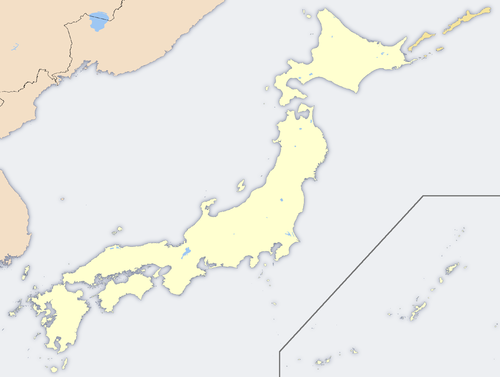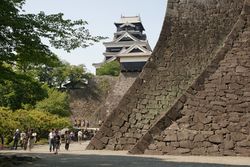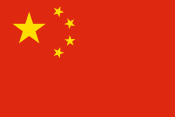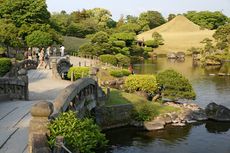Kumamoto, Kumamoto
| Kumamoto 熊本 |
|||
|---|---|---|---|
| — Core city — | |||
| 熊本市 · Kumamoto City | |||
 |
|||
|
|||
 |
|||
 Kumamoto
|
|||
| Coordinates: | |||
| Country | Japan | ||
| Region | Kyūshū | ||
| Prefecture | Kumamoto Prefecture | ||
| Government | |||
| - Mayor | Seishi Kōyama | ||
| Area | |||
| - Total | 389.53 km2 (150.4 sq mi) | ||
| Population (March 1, 2010) | |||
| - Total | 730,416 | ||
| - Density | 1,875.12/km2 (4,856.5/sq mi) | ||
| Time zone | Japan Standard Time (UTC+9) | ||
| City symbols | |||
| - Tree | Ginkgo | ||
| - Flower | Camellia | ||
| - Bird | Great Tit | ||
| Phone number | 096-328-2111 | ||
| Address | 1-1 Tetorisai-machi, Kumamoto-shi, Kumamoto-ken 860-8601 |
||
| Website | Kumamoto City | ||
Kumamoto (熊本市 Kumamoto-shi) is the capital city of Kumamoto Prefecture on the island of Kyūshū, Japan. Greater Kumamoto (ja:熊本都市圏) has a population of 1,460,000, as of the 2000 Census. It is never considered part of the Fukuoka-Kitakyushu metropolitan area despite both bordering each other.
Contents |
History
Kato Kiyomasa, a contemporary of Toyotomi Hideyoshi, was made daimyo of half of the (old) administrative region of Higo in 1588. After that, Kiyomasa built Kumamoto Castle. Due to its many innovative defensive designs, Kumamoto Castle was considered impregnable, and Kiyomasa enjoyed a reputation as one of the finest castle-builders in Japanese history. After Kiyomasa died in 1611, his son, Tadahiro, succeeded him, but Tadahiro was removed by Tokugawa Ieyasu in 1633, replacing him with the Hosokawa clan. Former Prime Minister of Japan Hosokawa Morihiro is a direct descendant of the Hosokawa clan of Kumamoto. Another famous politician, former president of Peru Alberto Fujimori, also has roots in Kumamoto; Fujimori's parents emigrated from Kumamoto to Peru early in the 20th century.
Mergers
- On February 1, 1991 the towns of Akita, Kawachi, Tenmei and Hokubu, all from Hōtaku District, were merged into Kumamoto.
- On October 6, 2008 the town of Tomiai, from Shimomashiki District, was merged into Kumamoto.
- On March 23, 2010 the town of Jōnan, also from Shimomashiki District; and the town of Ueki, from Kamoto District, were merged into Kumamoto.[1]
Landmarks

The city's most famous landmark is Kumamoto Castle, a large and, in its day, extremely well-fortified Japanese castle. The donjon (castle central keep) is a concrete reconstruction built in the 1970s, but several ancillary wooden buildings remain of the original castle, which was assaulted during the Satsuma Rebellion and sacked and burned after a 53-day siege. It was during this time that the tradition of eating basashi (raw horse meat) originated. Basashi remains popular in Kumamoto and, to a lesser extent, elsewhere in Japan, though these days it is usually considered a delicacy.
Within the outer walls of Kumamoto Castle is the Hosokawa Gyobu-tei, the former residence of the Higo daimyo. This traditional wooden mansion has a fine Japanese garden located on its grounds.
Miyamoto Musashi lived the last part of his life in Kumamoto. His tomb and the cave where he resided during his final years (known as Reigando, or "spirit rock cave") is situated close by. He penned the famous Go Rin No Sho (The Book of Five Rings) whilst living here.
Kumamoto is also home to Suizen-ji Jōju-en, a formal garden neighboring Suizenji Temple approximately 3 kilometers southeast of Kumamoto Castle. Suizenji Park is considered to be one of the most beautiful gardens in Japan, together with Kenroku-en in the city of Kanazawa, Ishikawa Prefecture, Kairaku-en in Ibaraki Prefecture and Koraku-en in Okayama Prefecture.
Suizenji Park is also home to the Suizenji Municipal Stadium, where the city's football team, Roasso Kumamoto used to play regularly, but nowadays they use the larger KKWing Stadium, northeast of the city.
Economy
Asiana Airlines operates a sales office on the fourth floor of the Asahi Shibun Daiichi Seimei Building in Kumamoto.[2]
Administration
The current administrative body of the "City of Kumamoto" was founded on April 1, 1889.
Transport
Local public transport is provided by the Kumamoto City Transportation Bureau.
Kumamoto Airport is located in nearby Mashiki.
Education
- Kumamoto University
- Kumamoto Gakuen University
- Kyushu Lutheran College
- Sojo University
- Prefectural University of Kumamoto
Sister cities
 Heidelberg, Germany since 1992[3]
Heidelberg, Germany since 1992[3] Guilin, China
Guilin, China San Antonio, USA [1]
San Antonio, USA [1] Billings, USA
Billings, USA Helena, USA
Helena, USA Bristol, United Kingdom
Bristol, United Kingdom Ulsan, South Korea
Ulsan, South Korea
Gallery
 Kumamoto Castle Keep Tower |
 View from Kumamoto Castle Keep Tower |
Kumamoto Castle at night |
 Suizenji Park |
Notes and references
- ↑ "都道府県別市町村変更情報:福岡." kokudo.or.jp. Retrieved on November 22, 2008.
- ↑ "Worldwide Offices Japan." Asiana Airlines. Retrieved on January 19, 2009.
- ↑ "Twinning". City of Heidelberg. http://www.heidelberg.de/servlet/PB/menu/1123762_l1/index.html. Retrieved 2009-11-12.
External links
- Official site of Kumamoto city
- Kumamoto, Kumamoto travel guide from Wikitravel
- Kumamoto Gakuen University
- Kumamoto Links
|
||||||||||||||
|
|||||||||||||||||||
